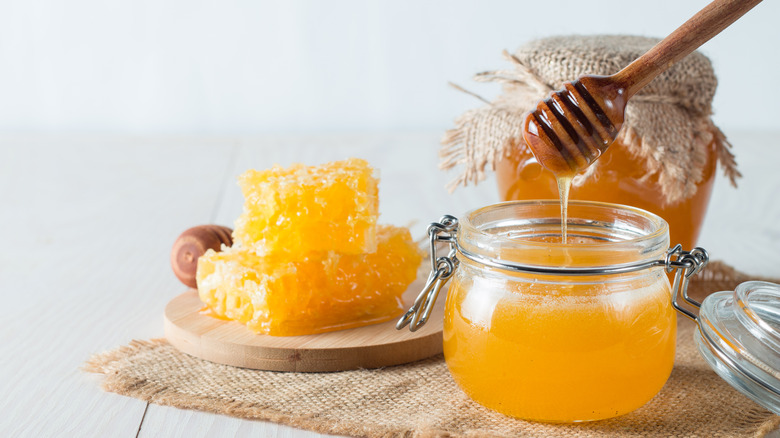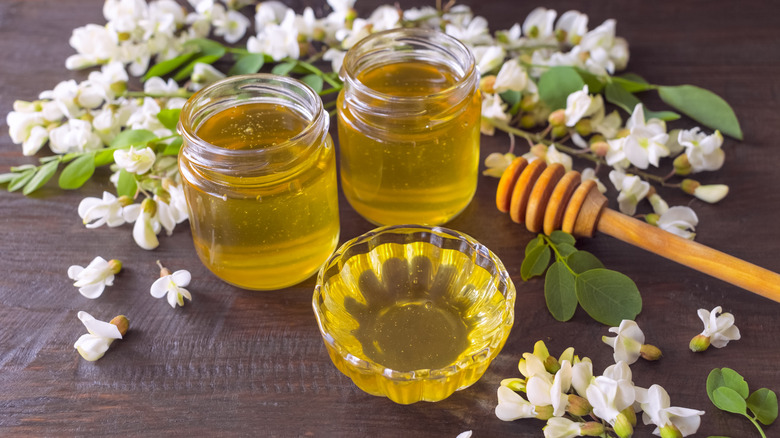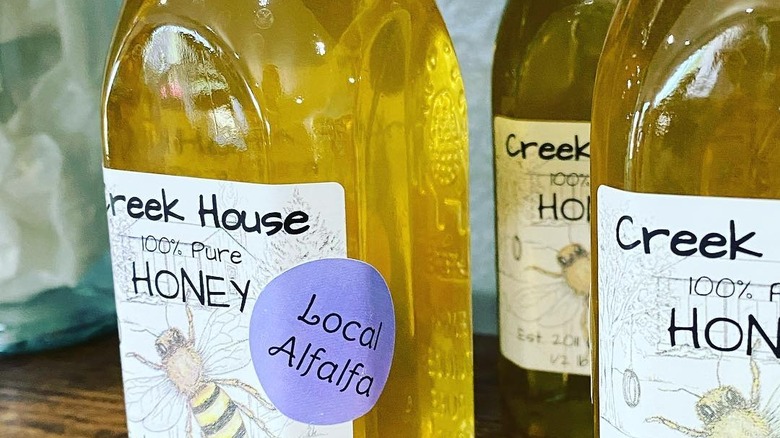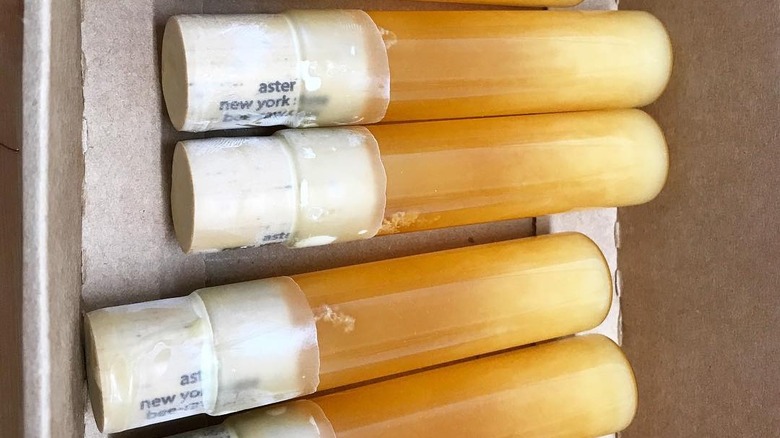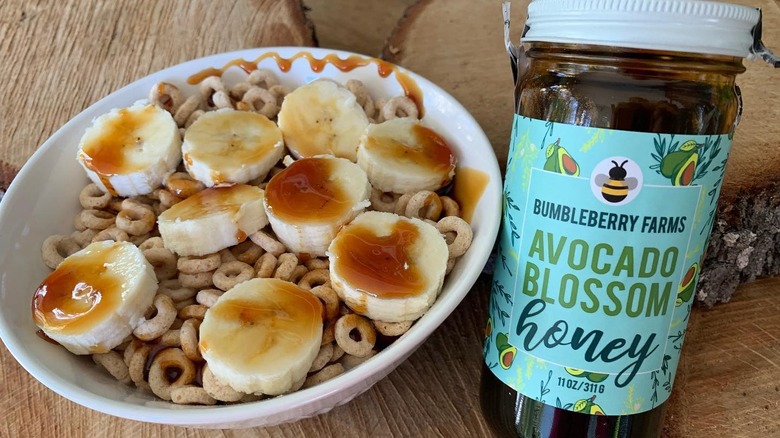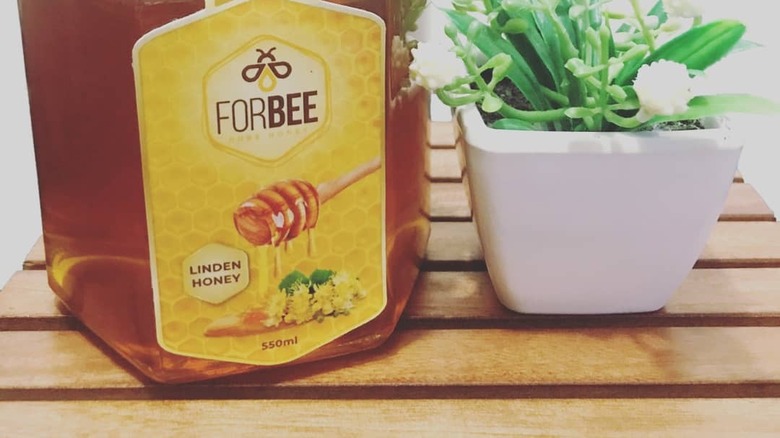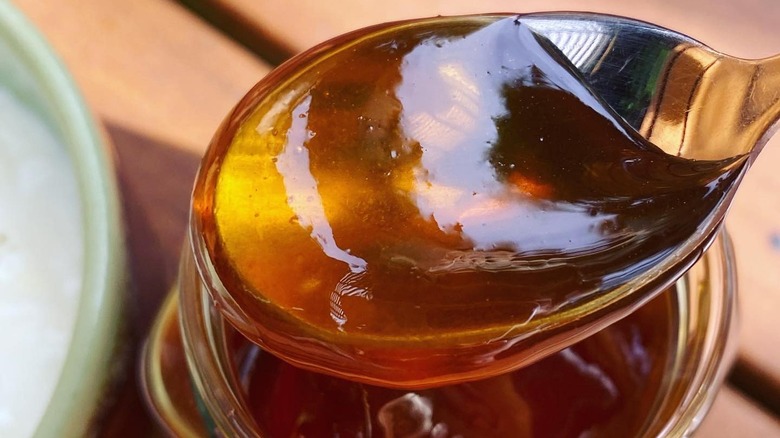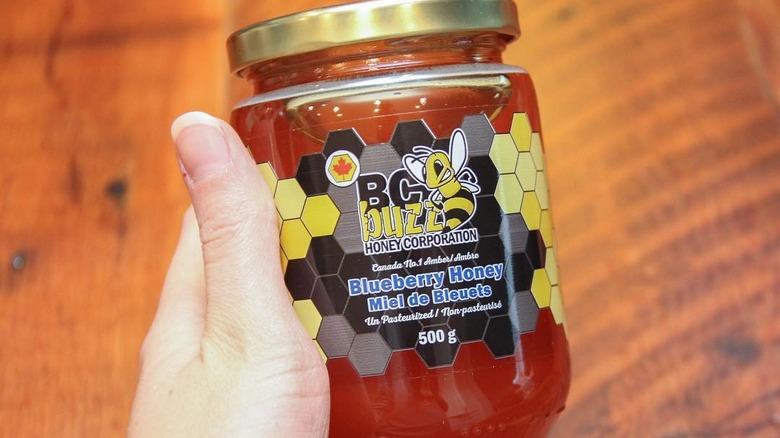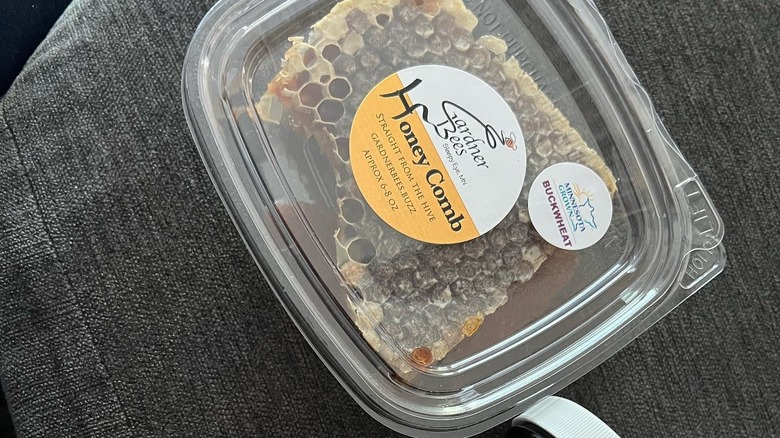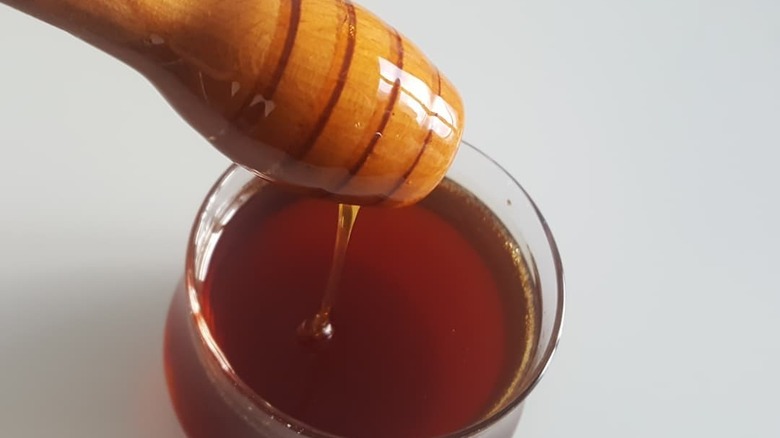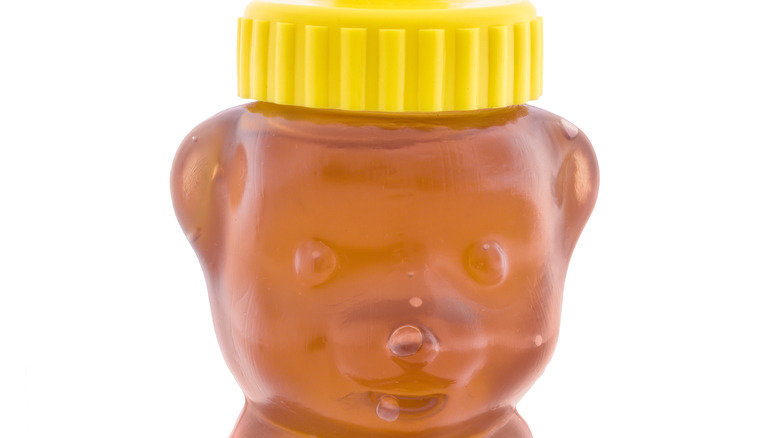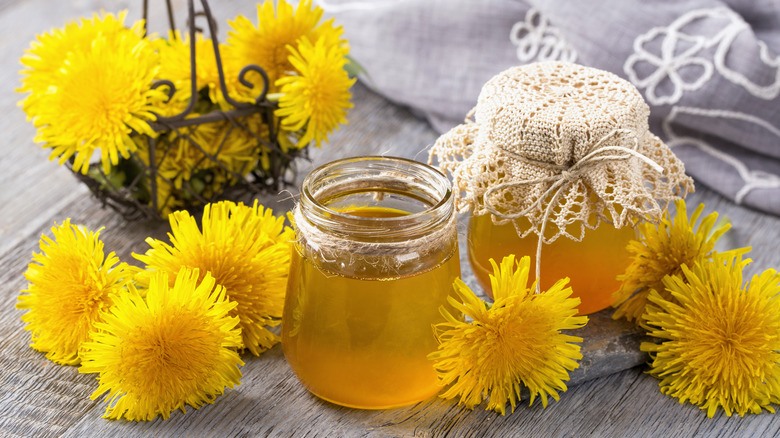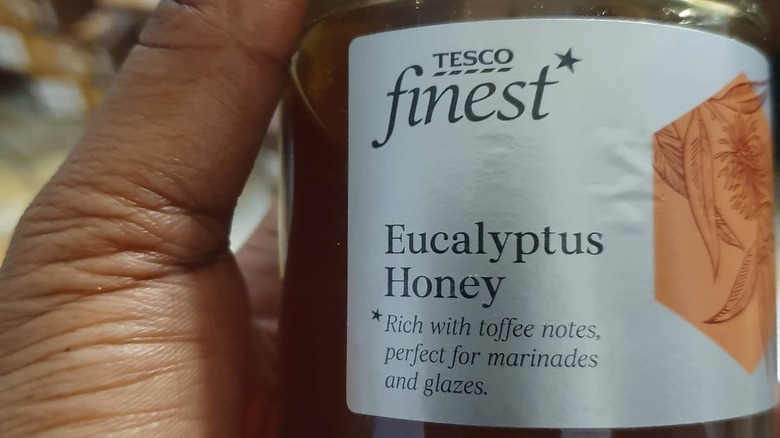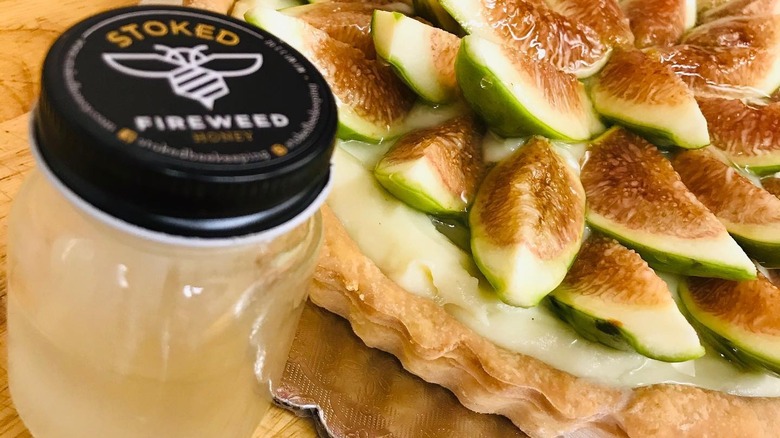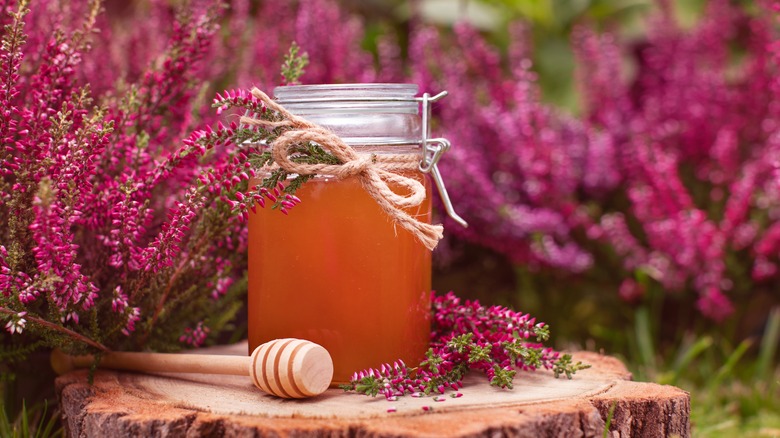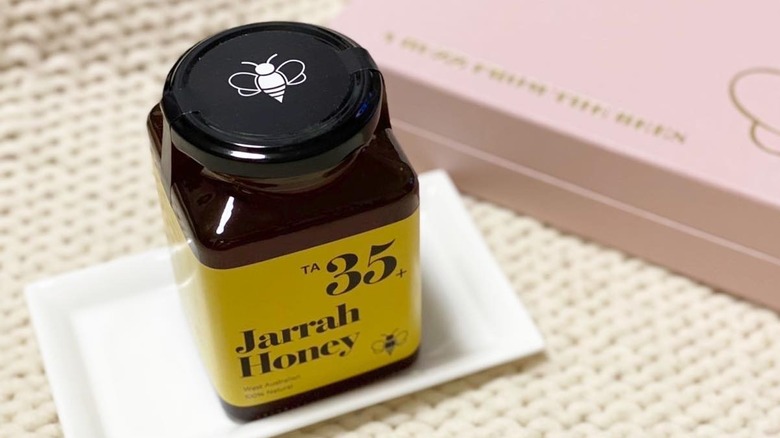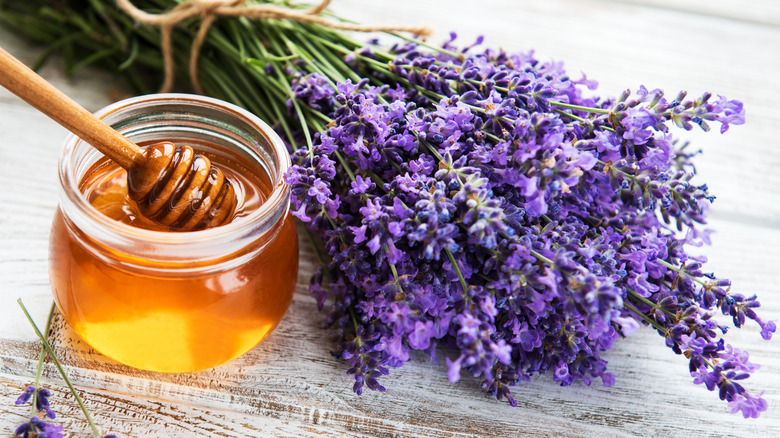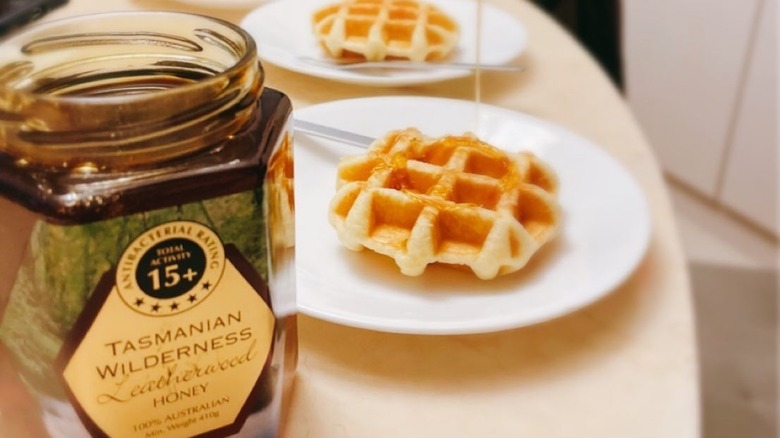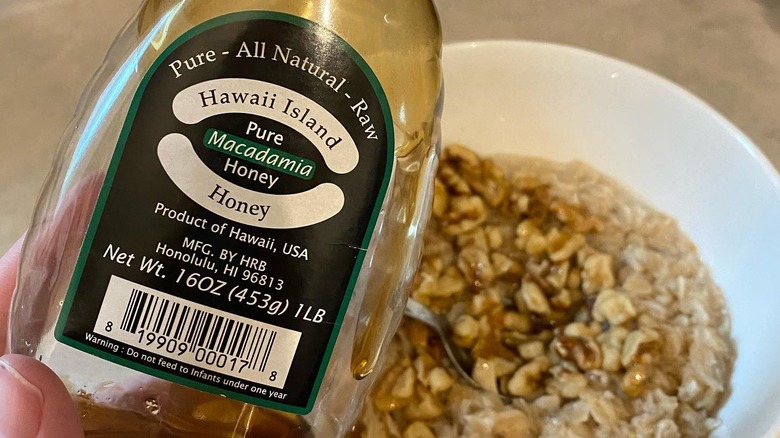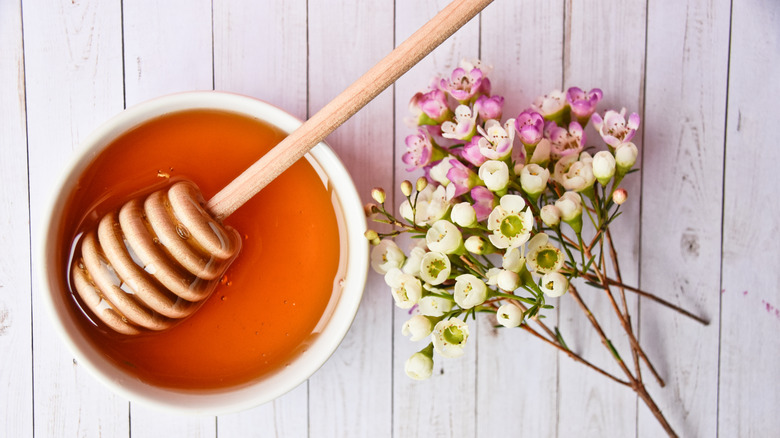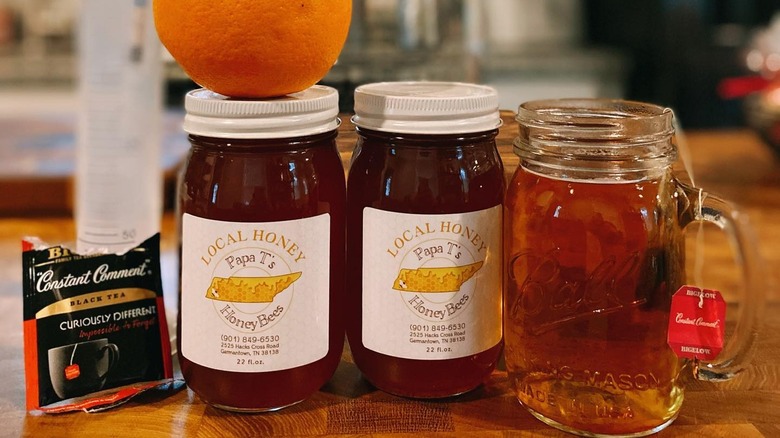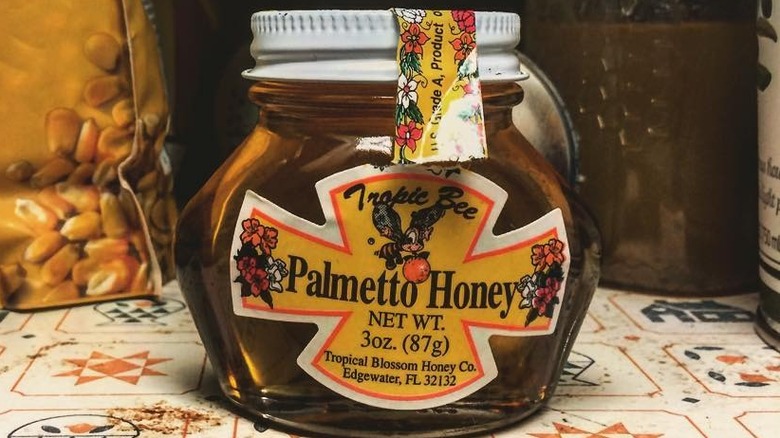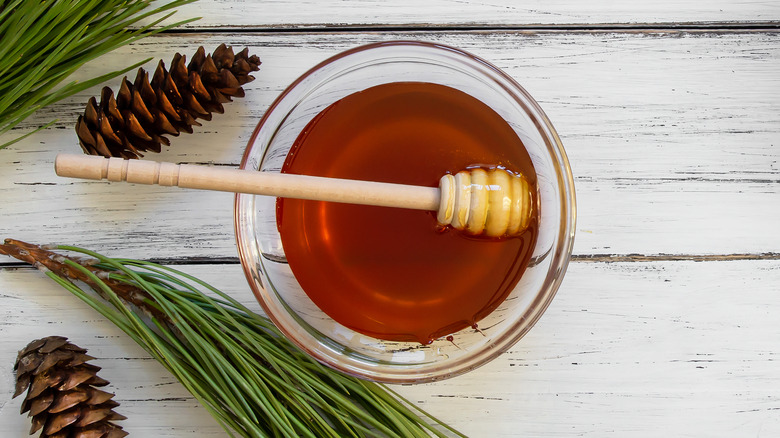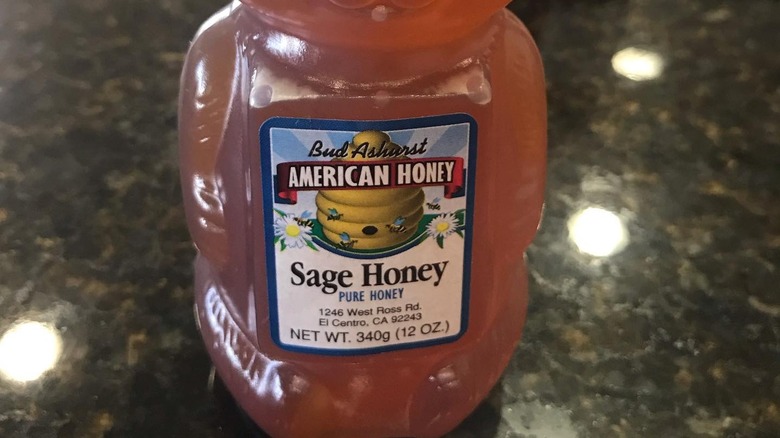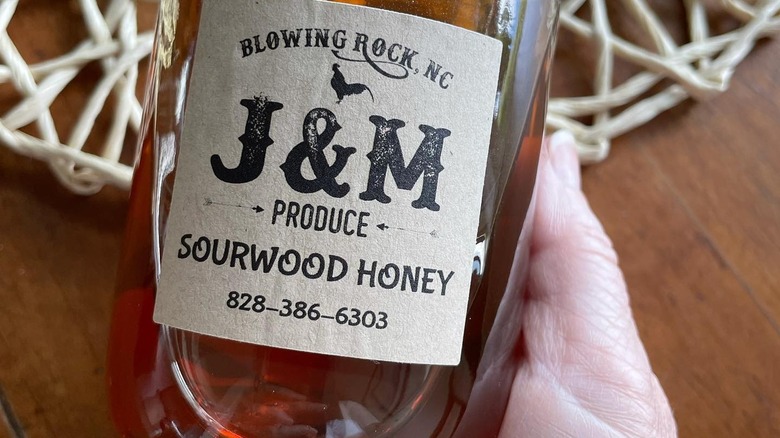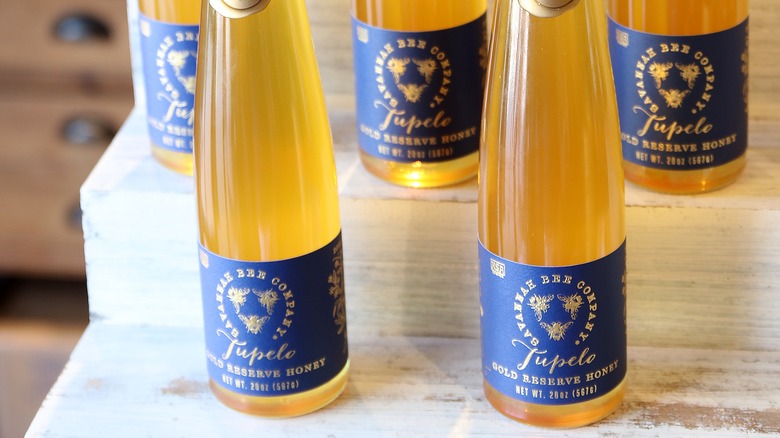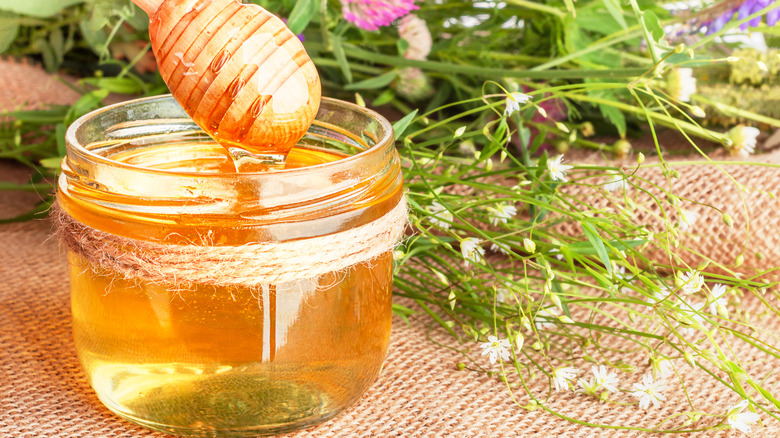26 Types Of Honey And What Makes Them Unique
The next time you're perusing the grocery store and find yourself reaching for that bear-shaped bottle of honey, think twice. While that familiar golden bear may get the job done as far as a sweetener is concerned, it's not the best honey. We've got the buzz on 26 types of raw honey that are way better than the stuff that's collecting dust in your pantry right now.
According to the National Honey Board, there are more than 300 varieties of honey in the United States alone. The flavor, color, and unique medicinal properties vary based on where the honeybees collect their nectar. Honey may be local (from a specific area), monofloral (from a single type of flower), or from a variety of flowers, which is called polyfloral or multifloral.
Lighter honey typically has a sweeter, milder flavor than darker varieties, which can be quite bold and even bitter rather than sweet. You may not notice a difference if you're adding it to a sauce or mixing it into your tea or smoothie, but the flavor nuances are noticeable when you slather some liquid gold on your biscuit, mix it into plain yogurt, or lick some from a spoon.
Try raw, unprocessed honey for yourself to taste the difference. Visit your local farmer's market, health food store, or specialty shop to find it. Meanwhile, read this sweet guide to some of the most popular honey varieties to decide which ones you'd like to try.
1. Acacia honey
Acacia honey is made by bees that feed off the flowers of the black locust tree, which is also called the false acacia tree. In North America, it's commonly marketed as locust honey, but in Europe it's sold as acacia honey (per Healthline). It is valued for both its taste and its medicinal properties.
Acacia honey has a floral aroma, a sweet taste with a hint of vanilla, and a light, almost transparent color. It is slow to crystalize, so it stays in its liquid form longer. Because of its mild, sweet flavor, it's a great one for kids and honey-averse adults to try. Mix it in yogurt, spread it on toast, stir it into your tea, or serve it with cheese.
Rich in antioxidants and antibacterial properties, acacia honey is used to encourage quick healing of wounds and may help prevent acne. If that weren't enough, it stopped the spread of lung cancer cells in one test tube study (via PubMed).
2. Alfalfa honey
According to Backyard Beekeeping, most alfalfa plants in the United States are grown to feed livestock. Most plants are cut down long before bees get a chance to pollinate them. However, some plants are reserved for honey making, though getting to the nectar is quite a challenge. The shape of the alfalfa flower makes it difficult for honeybees to access the keel, so beekeepers and farmers first employ leafcutter bees to trip the flowers' keel, opening them to expose the pollen and nectar.
This somewhat rare type of honey is a gem indeed, with a slightly bitter but overall sweet taste with hints of vanilla and mint. The taste is similar, though slightly less sweet, than clover honey. It has a floral aroma and is generally pale amber in color. Its mild flavor is ideal for a number of culinary uses, such as making salad dressings and sauces, pairing with cheese, or serving over your pancakes or waffles.
Medicinally, its antiseptic properties make it useful in treating wounds, soothing sore throats, and calming stomach irritation. It also has prebiotic and probiotic effects, stimulating the growth of healthy bacteria in the gut.
3. Aster honey
Found primarily in the Mid-South region of the United States, aster honey is a type of monofloral honey that has a strong odor when it's first harvested. Fortunately for all of us, it mellows out as it ages to produce a smooth, thick honey with a sweet taste and aroma. Use it as a sweetener for your drinks, a topping for your morning muffin, or as a sugar substitute when baking and cooking.
Like many honey varieties, aster honey can be used for treating wounds since it both dries them out and hampers growth of bacteria and fungi. While honey may promote wound healing in some, a different study in The Lancet has shown that it may increase infection in people with diabetes, so use caution and follow the advice of your doctor.
You may have some difficulty finding aster honey is a monofloral honey, but it's more widely available as a predominant source in multifloral wildflower honeys.
4. Avocado honey
Avocado honey is dark in color (thanks to being high in polyphenols) and is produced by bees that collect nectar from avocado blossoms. The number of bees that are attracted to avocado blossoms, however, is low. The blossoms are rich in minerals like phosphorus and magnesium, which, according to PubMed, deters honeybees. Young bees don't mind them, but mature bees prefer sweeter, more citrusy flowers.
If you can get your hands on some avocado honey, you'll find it to be thick and creamy in its consistency. It looks and tastes a bit like molasses and is good in any culinary instances where you'd use molasses. Use it to drizzle over cereal, desserts, or fruit or as a sugar substitute in baking a batch of cookies.
Avocado honey is helpful for anemia and deficiencies of other minerals. But according to Healthy with Honey, those who suffer from kidney disease should avoid avocado honey due to its high phosphorus content.
5. Basswood honey (aka linden honey)
By any other name, it would be just as sweet. Basswood honey, commonly known as linden honey or lime honey, is produced by bees that pollinate trees in the Tilia genus found in the Northern hemisphere. The trees are incredibly popular with insects and draw honey bees to it. A single tree can produce an incredible 40 pounds of nectar!
Although this honey is light in color, it tastes slightly minty and bitter and has a noticeably different flavor. It tastes woody and spicy with a woodland and menthol aroma. This hint of mint makes it a good option for stirring into hot beverages like tea or coffee or adding to savory dishes as a drizzle, marinade, or sauce.
According to Backyard Beekeeping, basswood honey is rich in maltose, which helps in digestion. Other medicinal uses include soothing sore throats and coughs, inhibiting bacterial growth, and detoxifying the organs, especially the liver and gallbladder. It is a popular choice for beauty treatments like facials and wraps, too.
6. Beechwood honey
Beechwood honey is also called honeydew honey because it is sourced from sap produced by beech scale insects rather than from flower nectar. This makes it relatively pollen-free since flowers aren't involved. It is produced mainly in south New Zealand where the beech trees and the scale insects that produce the honeydew are an important part of the ecosystem. Unfortunately for honeybees, other insects are attracted to the honeydew as well. In fact, wasps account for 90% of the honeydew consumption and will kill honeybees that try to get the sweet stuff.
This dark, sweet honey is versatile in cooking. Add it to your smoothie or tea, use it to make sauces, or drizzle it over your breakfast foods.
According to Science Daily, honey made from honeydew is higher in antioxidants than honey made from nectar. According to Scientific Reports, it's also potent as an antibacterial agent due to the "polyphenolic compounds and their interaction with H2O2." So, it seems this honey is as useful in your medicine cabinet as it is in the kitchen.
7. Blueberry honey
It's a common misconception that blueberry honey is a type of honey infused with blueberries, but that's not true. Like other varieties, it's made from the nectar bees collect from blueberry blossoms. It's amber in color and has a hint of fruity flavor. It pairs beautifully with beverages, poured over baked goods, or stirred into oatmeal.
Blueberry-infused honey, on the other hand, is any type of honey that's been mixed with blueberries and is purple to blue in color. Both are delicious, but blueberry blossom honey is what you're looking for if you want it in its raw form.
According to the University of Maine, honeybees are such effective pollinators for blueberry bushes that blueberry growers rent hives during the blooming season. The beekeeper brings the hives on site, but the growers may be expected to provide protection for the hive (from animals and insecticides) as well as ensure the bees have water.
A study in the National Library of Medicine indicates that blueberry honey and buckwheat honey both have antibacterial properties. Additionally, blueberry honey is high in antioxidants and flavonoids, which are good for the immune system and for fighting inflammation.
8. Buckwheat honey
Buckwheat honey is produced by bees that pollinate the buckwheat flower. Because this flower is dark in color, the resulting honey is darker, too, often a dark purple to black color. Because the flowers are so small, bees have to work harder to draw nectar from and pollinate these buckwheat flowers.
It is less sweet than traditional honey but is still a good all-around sweetener for baked goods, beverages, and savory foods. Stir it into a hot toddy, make a glaze for your salmon, or drizzle it over roasted veggies.
Like most darker honeys, buckwheat honey is high in antioxidants. According to Healthline (via the American Chemical Society), it has a wide range of health benefits, from lowering cholesterol to improving high blood pressure. According to a clinical trial published in the Journal of the American Medical Association, buckwheat honey was ranked higher by parents than DM cough medicine for soothing nighttime cough in children.
9. Chestnut honey
People either love or hate chestnut honey. According to Serious Eats, it has a very distinct flavor that's described as dark, spicy, smoky, and leather. It also has a bitter or savory aftertaste, so it's not for everyone, especially those with a strong sweet tooth who expect honey to be nothing but sweet and mild. The spicy, leathery flavor is the perfect choice for your charcuterie board because chestnut honey pairs well with meats and cheeses.
Chestnut honey is produced by bees that get nectar from chestnut blossoms, which are found in the United States, Italy, Japan, and other regions. Although 84% of the honey comes from blossom nectar, 16% of chestnut honey comes from honeydew (via Bees Wiki). The color of this honey ranges from golden brown to nearly black.
As for its health benefits, chestnut honey is a good antimicrobial and is high in antioxidants, which helps protect your cells against free radicals.
10. Clover honey
Made by bees that collect nectar from clover flowers, clover honey is one of the most common varieties found in grocery stores (often in bear-shaped bottles). With more than 300 species of clover, it's one of the more readily available types of honey. It's a lighter colored honey with a mild, sweet flavor that can be used as a sugar substitute, stirred into yogurt, in your oatmeal, mixed with granola, drizzled over fruit, or mixed into smoothies and other drinks.
Although lighter colored honeys have fewer antioxidants than darker varieties, clover honey is still high in flavonols and phenols, which improve heart health by reducing high blood pressure (via WebMD). It also helps with lowering LDL cholesterol, neutralizing free radicals, killing bacteria (to help with coughs and sore throats), and promotes a healthy brain.
While honey is considered a healthier sweetener than sugar, moderation is key since it is an added sugar with high caloric content.
11. Dandelion honey
There's some confusion about dandelion honey because there are both natural and manmade varieties. However, only the natural type is true honey. The recipes you find for making dandelion honey are actually a thick dandelion syrup made from the flavors. The honey, however, comes from bees that feed on nectar from dandelion blossoms. It's golden yellow to dark amber with a wide variation in flavors from sweet and mild to sharp, and slightly astringent (per Healthy With Honey). It also crystallizes quickly.
Like the greens from dandelions, dandelion honey has many health benefits. For instance, it stimulates the immune system; promotes healthy function of the liver, kidneys, and gallbladder; and increases the pH of gastric juices by more than 56% (via Lithuanian University of Health Sciences).
Because of its sharp taste, this honey is best paired with something sweet to balance out the flavor, but you can also enjoy it with a mild cheese (like cream cheese) on crackers.
12. Eucalyptus honey (aka blue gum honey)
If you've smelled eucalyptus oil or anything containing eucalyptus, you have a good idea what eucalyptus honey smells like. It's dark in amber in color and menthol-like in aroma. Lest you think eating it will taste like a sweetened version of Vicks VapoRub, Feast Magazine describes the flavor as creamy but includes such flavor notes as butterscotch and even a slight hint of menthol. Some find it appetizing and some don't. But if you do, you can use it to add flavor and aroma to your hot tea, salad dressings, cocktails, desserts, or meats. It's also a tasty addition to marinades and glazes.
While it is considered a monofloral honey, there are more than 660 species of eucalyptus, many of which are found in Australia.
According to Backyard Beekeeping, eucalyptus honey is higher in vitamins C and B9 than other types of monofloral honey. The eucalyptol compounds make it ideal for treating respiratory ailments, as it serves as a decongestant and expectorant. A study published by the University of Sydney found that jarrah, a type of eucalyptus honey we'll cover in more detail later, shows "exceptional" antimicrobial activity.
13. Fireweed honey
It's time for a toast! This variety is known as the "champagne of honey" because of its pale golden color and delicate flavor. It's also often sold at a premium price, so if you like your honey on the swankier side, this one's for you.
Its flavor is fruity with hints of vanilla, so it's a tasty addition to drinks like cocktails and smoothies, but it's ideal for drizzling over sweets, too. Because it's on the more expensive side, it's not exactly one you'd want to use as a sugar substitute in baking, which usually involves large quantities of honey.
Fireweed honey comes from bees that pollinate the fireweed flower — a plant known for quickly colonizing areas burned by wildfire. In North America, it is found in the Pacific Northwest, Midwest, Northeast, Alaska, and Canada. According to Bees Wiki, getting monofloral fireweed honey is difficult because other wildflowers tend to bloom at around the same time.
Among its health benefits are preventing and stopping bacterial growth, particularly those that cause staph infections. It can also be used to treat wounds and acne.
Like the dandelion, man-made versions of fireweed honey are made by boiling the flowers of the plant. This, however, is a syrup, and not true honey.
14. Heather honey
A rare type of honey due to the short blooming season of heather shrubs, heather honey is highly valued in Scotland where heather is a national symbol. Heather shrubs also grow in Wales, Ireland, Germany, and other European countries.
Heather honey ranges in color from reddish-orange to dark amber. It's a highly aromatic variety with notes of caramel, mint, and sage (per Saveur). The flavor is mild, sweet, and floral, though it can also be slightly bitter or smoky. While it's not recommended for cooking because it can overpower other flavors, it is a tasty addition to your morning oatmeal or toast.
According to Honey Traveler, only Ling heather is considered the true "heather honey." In the honeycomb, it is firm like a gel, but it can become liquid when it's stirred enough. It can't be extracted by spinning like most honey varieties — heather honey must be pressed out.
Similar to manuka honey as far as health benefits go, heather honey is high in antioxidants, fights infection, and promotes healing.
15. Jarrah honey
Sorry, not sorry, manuka honey, but there's a new superfood in town! Found in Southwestern Australia, jarrah honey has become one of the most expensive varieties on the market, and for good reason. With more than three times the amount of antioxidants and 90% more antimicrobial activity, it is a health powerhouse (via Daily Mail). However, according to Backyard Beekeeping, the trees only flower once every two or three years, which is a factor in its price.
Bees collect nectar from the white flowers of the jarrah tree to make this monofloral eucalyptus honey. It's medium to semi-dark in color and is more syrup-like in consistency than other types of honey, so it's also slower to crystalize.
The flavor is described as nutty and caramel-like with a fruity aftertaste. It works well with sweet or savory dishes, making it a good choice for your afternoon tea or your after-dinner cheesecake. Jarrah honey improves gut health, because of its prebiotic properties.
16. Lavender honey
Nothing calms quite like lavender, but does the honey give you that same Zen feeling? Not to be confused with lavender-infused honey or man-made lavender syrup that people often call honey, true lavender honey is made by bees that collect nectar and pollen from lavender flowers.
According to Wise Geek, the honey is light in color with a lavender aroma. It even tastes like lavender too, with a medium-sweet flavor that can sometimes be slightly slower, according to Honey Traveler. Drizzle it on pancakes, bread, or muffins, or stir it into your tea. Serve it with cheeses — feta, blue cheese, and other soft cheeses mingle nicely with lavender honey.
According to the Journal of Food Science and Technology, lavender honey is an effective antifungal, suggesting that it may in the future be useful in treating fungal infections of the skin. A study conducted with rats also found it to be useful in wound treatment (via Phytotherapy Research).
17. Leatherwood honey
Produced almost exclusively in the wet, marshy regions of the Tasmanian rainforests, leatherwood honey comes at a premium price. The honey is produced by bees that gather nectar from the leatherwood trees, which only blossom between January and March. That leaves a short time for bees to collect nectar and make honey. Beekeeper and honey maker Lindsay Bourke tells ABC News that the rainforests in Tasmania can only accommodate about 20,000 hives each year, and space is limited.
According to Honey Traveler, this variety is "musky and spicy." Healthy With Honey describes it as clean, fresh, and balsamic with lightly spicy notes. Clearly, this ochre-yellow honey has a distinctive and desirable flavor with a lingering aftertaste.
What can you do with this spicy, bold honey? It's best with breads, savory dishes, hot drinks, and in sauces, marinades, and salad dressings. Like other darker honeys, leatherwood is rich in antioxidants.
18. Macadamia honey
If you enjoy a slightly nutty flavor in your sweeteners, try macadamia honey. It's produced by bees that pollinate the white macadamia nut blossoms. According to Smithsonian Magazine, most of the world's macadamia nuts are grown in Hawaii even though they are indigenous to Australia. Hawaii and Australia both produce macadamia honey, but Hawaii leads production worldwide. The macadamia honey produced in Hawaii is a monofloral honey, but Australia's version is considered multifloral because the bees feed on other flowers and red gum trees nearby.
It is commonly used for making a type of dessert wine, but is also enjoyed over ice cream or pancakes, stirred into your oatmeal or yogurt, or as a spread for your toast or baked goods.
Macadamia honey is typically dark amber in color, but the color, aroma, and taste can vary depending on the region, which influences the bees' other food sources.
19. Manuka honey
Originating in Australia and New Zealand, manuka honey has been a popular choice with health gurus for years now. Its antibacterial properties are 100 times higher than regular honey (via Cleveland Clinic), and it's FDA-approved for treating wounds. Manuka honey is also effective at soothing sore throats, preventing tooth decay, treating acne, and preventing ulcers (via Healthline). Talk about an impressive food! Look for the Unique Manuka Factor rating when shopping for this type of honey. The higher the value, the stronger and more expensive the honey. It needs a UMF of 10+ to be considered therapeutic (via Epicurious).
Manuka honey is made by bees that pollinate manuka bush flowers. It is not as sweet as regular honey, but rather has a slightly bitter, earthy taste. Raw manuka honey is on the pricier side, so you probably won't use it in large quantities. Instead, mix a teaspoon into your tea or yogurt to reap its many health benefits.
20. Orange blossom honey
This thick, lightly-colored monofloral honey is produced by bees that extract nectar from orange blossoms. In the United States, you can find orange trees (and thus, honey) in California, Texas, and Florida, with most orange blossom honey coming from the latter. According to the University of California's Agriculture and Natural Resources website, orange trees rely on bees for 90% of their pollination.
With its sweet, fruity, slightly citrus flavor, you can use orange blossom honey for just about anything you'd use clover honey for. Cooking, baking, sweetening drinks, and spreading on breakfast foods like scones or biscuits are all fair game.
One of the biggest benefits of this honey variety aside from its unique flavor is that it is a low-pollen honey. Orange blossoms produce a lot of nectar but very little pollen. So, those with mild allergies may be able to enjoy it.
21. Palmetto honey
Popular in Florida and the surrounding Southern states, palmetto honey is described as having a salty, smoky flavor that's fruity with caramel and woodsy notes. The flavor is less sweet than traditional honey you'd find on the grocery shelf. It is produced by bees that gather nectar from the palmetto trees, which are in bloom from April to July (via Backyard Beekeeping). Because the trees are high in pollen and low in nectar, the honey is produced in small quantities and, therefore, rarely makes an appearance outside of the Southeastern United States.
Saw palmetto honey has a deep amber color that's slow to crystalize. Like other deep-colored honeys, it is high in antioxidants and helps neutralize free radicals in the body (via Science Daily).
It's a great sweetener in tea and coffee, is used in homebrews and cocktails, and makes a terrific glaze for cured meats like ham, smoked pork, bacon, and sausages.
22. Pine honey
Like the beechwood honey mentioned earlier, pine honey (or forest honey) is a type of honeydew honey produced from fir, spruce, and pine trees. It's produced primarily in Greece, Italy, and Turkey with the latter accounting for 92% of production, according to Daily Sabah. The bees that make this honey do not gather nectar from blossoms. Instead, they turn honeydew left by scale insects (Marchalina hellenica) into honey via a similar process.
A study published in MDPI shows that pine honey is antibacterial with "multiple mechanisms." According to Healthy With Honey, it's also helpful for various skin and respiratory conditions.
The aroma of pine honey is as you'd expect — woodsy and warm. It has a medium-strong flavor that's sometimes astringent and pairs perfectly drizzled in yogurt or over bread. It also mixes well into your favorite hot tea. It's typically dark reddish-brown in color or darker and is slow to crystalize.
23. Sage honey
Odds are you have sage in your kitchen. It's a favorite herb for pasta, pizza, and holiday meals, but sage flowers are a favorite for honeybees! The bees gather nectar from the sage flowers in early spring through late summer to turn it into honey back at the hive. In the United States, sage is found mostly in California and Texas. This honey is quite aromatic because one of the ways beekeepers know they have honey to harvest is by the aroma around the bee colony.
In California, sage honey is gathered from black button or white sage, meaning the honey is lighter in color. In Texas, sage flowers are purple, and the resulting honey is dark purple to black (via Bees Wiki). High in flavonoids, prebiotics, and probiotics, sage honey is great for the digestive tract. It can also soothe sore throats and coughs and help with wound care.
Backyard Beekeeping describes the taste of sage honey as sweet with a floral aftertaste. Spread it on muffins, drizzle it in your tea, or glaze a pork loin with it. You'll find it's a tasty addition to sweet or savory foods.
24. Sourwood honey
Native to the Appalachian region, sourwood trees with their white, bell-shaped blossoms are the source of the nectar bees use to make this honey (via Carolina Honeybees). Despite its name, there are no sour notes to this honey. It is sweet, rich, and buttery with a light amber color. The flavor is light, so it pairs well with herbal teas, is tasty in salad dressings, and adds an extra layer of sweet flavor when drizzled over roasted sweet potatoes.
The amount of nectar the sourwood trees produce is based on elevation. Those in the mountains produce more nectar than trees in the Appalachian foothills.
The health benefits are similar to any other honey. It's sought after because of its flavor more than anything else. Sourwood is so beloved in Black Mountain, North Carolina, that they hold a Sourwood Festival every year. You're sure to find a jar or two of honey there!
25. Tupelo honey
According to The Spruce Eats, rock star Van Morrison made this rare honey produced in Georgia and Florida a household name when he released an album titled "Tupelo Honey." The New York Times calls it "the most expensive honey in America." That's more due to the fact that the trees only have a two-week blooming season rather than its being on a rock album.
Tupelo honey is produced by bees that pollinate tupelo tree blossoms in Florida and Georgia near the swamplands. It has a slight green tint and crystallizes slowly.
The flavor is described as sweet and buttery with light notes of florals and cinnamon. Then again, it also has notes of anise, jasmine, and citrus. No wonder it's so highly sought after. It's rare and expensive, so rather than using it in a recipe where its flavors get hidden, let it be the star of the show. Pair it with aged cheese, crusty bread, fresh fruits, or deli meats.
26. Wildflower honey
While we've covered many monofloral honeys and single-source honeydew honeys, most honey is multifloral (via Carolina Honeybees). That is, the nectar the bees bring back to the hive comes from a variety of different flowers. One popular type of multifloral honey is wildflower honey. And while that sounds simple, because the species of wildflowers vary from one region to the next, so does the taste and aroma of wildflower honey.
Bees gather nectar in uncultivated fields of wildflowers where they're not attracted to one particular flower but rather gather nectar and pollinate a variety of them. Not only does the flavor depend on the region, but which flowers were in bloom at the time the bees collected their nectar is a major factor. Still, you can count on wildflower honey being light to dark brown and sweet, floral, and fruity in flavor. Enjoy it in baked goods, glazes for meat, or as a sweet, fruity addition to your smoothies or tea.
Like other types of raw honey, wildflower honey is a great anti-inflammatory, is high in antioxidants, and promotes digestion.
